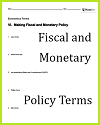| Making Fiscal and Monetary Policy |
| www.studenthandouts.com > Social Studies > Economics > Fiscal and Monetary Policy |
 |
||||||||||
| Fiscal and Monetary Policy Vocabulary Terms Sheet | What are tariffs? Worksheet |
|
A country's fiscal and monetary policies are two crucial tools it uses to manage its economy, control inflation, promote economic growth, and stabilize financial markets. These policies are typically formulated and implemented by separate branches of government or governmental agencies, each with its own set of tools and objectives. It is imperative that students understand these concepts. Our free printable worksheets are designed to facilitate this learning. Fiscal Policy: Fiscal policy involves decisions related to government spending, taxation, and borrowing. It is primarily managed by the legislative branch (e.g., the U.S. Congress) and the executive branch (e.g., the president's administration). Here's how a country makes its fiscal policy:
Legislative Approval: The legislative branch reviews, amends, and approves the budget proposal. This process often involves negotiations, debates, and compromises to determine the final budget. Taxation Decisions: The government also makes decisions about taxation, including income taxes, corporate taxes, sales taxes, and other forms of revenue generation. These decisions can be influenced by fiscal and economic objectives. Deficit/Surplus Planning: Fiscal policy decisions may involve deficit spending (spending more than the government collects in revenue) or planning for surpluses (collecting more than it spends). This choice can have significant implications for the economy. Implementation: Once the budget and taxation policies are approved, the government agencies responsible for implementing these policies carry them out. This can involve allocating funds to various government programs, services, and infrastructure projects.
Tools and Instruments: Central banks use various tools and instruments to implement monetary policy. These can include open market operations (buying or selling government securities), adjusting the discount rate (the interest rate at which banks borrow from the central bank), and reserve requirements (the amount of funds banks are required to hold in reserve). Data Analysis: Central banks continually monitor economic data and financial markets to assess the state of the economy and the effectiveness of their policies. This analysis guides their decisions on whether to tighten or loosen monetary policy. Communication: Central banks often communicate their policy decisions and intentions to the public and financial markets to provide transparency and manage expectations. Independent Decision-Making: Many central banks operate independently from the government to avoid political influence and ensure that monetary policy decisions are made in the best interest of the economy. |
| www.studenthandouts.com > Social Studies > Economics > Fiscal and Monetary Policy |






